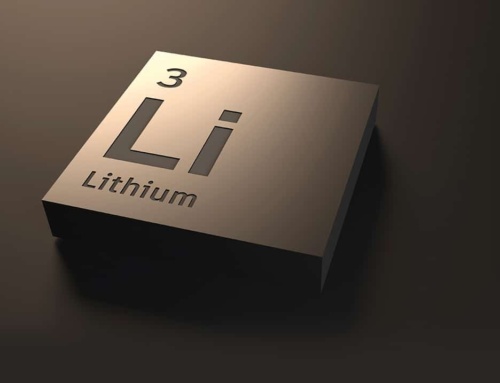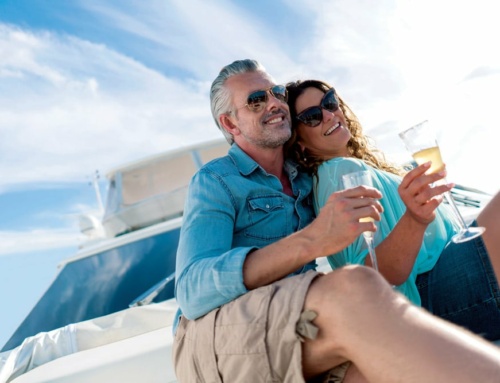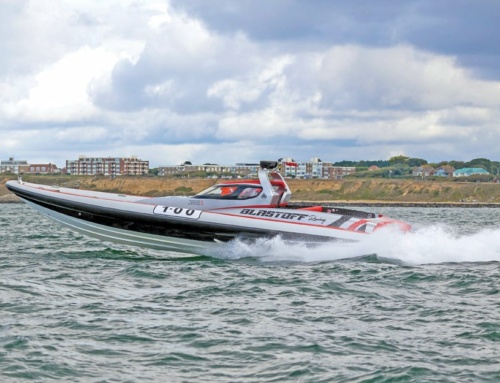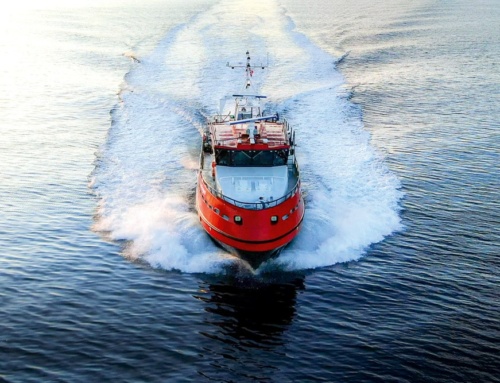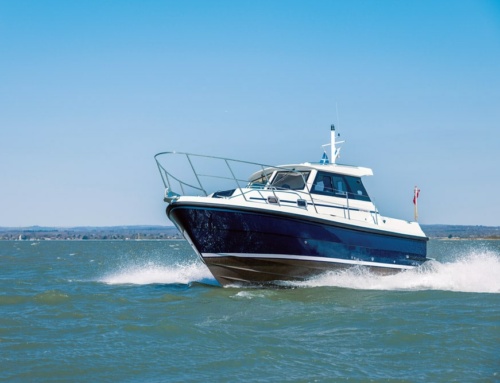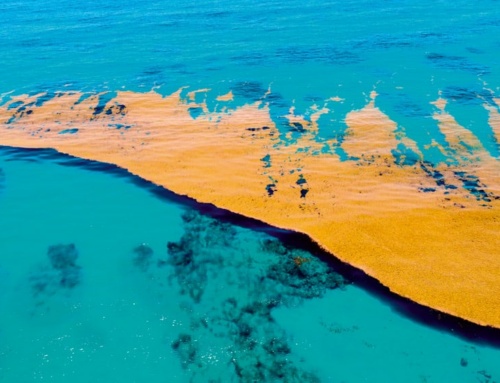Peter Dredge has won two world and three European championships and has broken 21 world speed and endurance records, 15 of which still stand. In this exclusive interview with PBR, Peter reveals the facts behind his Vector Team’s most recent world record.
Tell us about how the idea was born and what the motivation was behind the plan to take the electric-powered boat title …
I was the RYA powerboat racing manager back in 1988 when Fiona, the Countess of Arran, first raised the question of how she could attempt an electric world record as there was no such category at that stage in the UIM or RYA rule book. We were able to get RYA and UIM sanction and then followed it through to a very cold November day when a record of over 50mph was established. Fast-forward to 2017, when we learned that Jaguar were to become the first manufacturer to enter Formula E – they were an ideal fit to partner such a project.
Can you shed some light on the role that each of the parties played and the input each shared toward achieving the ultimate goal?
Our partnership is with Jaguar, who work very closely with Williams Advanced
Engineering (WAE) as technical partner of Panasonic Jaguar Racing in ABB FIA Formula E. An introduction was facilitated by Jaguar and WAE became a technical partner to the project and to Vector. Vector came up with the concept and sourced the boat to use. WAE identified the choice of motors and inverters, and designed the VCU for the project as well as designing the electrical and cooling systems. Vector then teamed up with a local company, Composite Specialities, who integrated the batteries into the boat, ensuring that the structural strength was not compromised and that the aerodynamics of the boat was not affected. Vector designed and manufactured the parts required to integrate the WAE system into the boat’s systems.
What came first, the designing of the boat or the development and building of the engine?
The boat and propulsion system were selected first by Vector. WAE then specified the most suitable motor, batteries and inverters to match the requirement of the project.
Tell us about the boat and its key features and systems …
The boat started life as a Formula 1 circuit catamaran. It weighed 550kg and would have used a Mercury 2.5L V6 2-stroke engine. The Jaguar Vector electric records boat has a length overall of 5.4m and a 2.2m beam. The rules for this category of Outright Electric Record require the same level of safety as a Formula boat, so it has a 3000-newton homologated safety cell as well as all the current requirements of 100mm head clearance, two air systems (one for the driver and a second system for the automatic actuated accident airbag system) etc. All this safety equipment plus the WAE electrical system increased the weight of the boat to 880kg.
The collaborating of two world-renowned automotive companies with a marine project is quite unusual. What is the special attraction for Jaguar and Williams to be the sponsors of such a project and a powerboat race team such as Vector?
Jaguar are seen as a performance lifestyle brand in the same way as Vector. As such, a targeted association with the marine industry, particularly in pushing the boundaries of all-electric performance, is a logical and credible association.
Please tell us about the all-important engine and how it was developed.
The project is ongoing, so at this stage I am sure you can appreciate that many details of the technical workings of the engine and its development remain confidential.
What benefits, both commercial and in terms of technology, do you see as a result of having achieved this world record and the successful completion of the project in general?
The main motivation of this project is to learn as much as we can about this exciting and fast-developing technology, which is becoming increasingly accessible to the marine industry. The benefits of being a market leader in this sector are obvious.
To what degree do you see electric power being the future of the automotive world and a viable source of power in the marine market?
We now see sufficient evidence to show that the maritime industry may look very different in a few years’ time. With regards to the automotive market, Jaguar are committed to electrification with the recent launch of the all-electric Jaguar I-PACE and their involvement in ABB FIA Formula E.
Going forward, do Williams and Jaguar have any additional plans of this type involving the marine world?
Vector are committed to working with both partners to explore this area. There are several more ideas currently under consideration against a range of deliverables, and these are being assessed for practicality, suitability, benefits and reliability.
Obviously, taking the title on Coniston was the pinnacle, but in addition to this, what was the best, most rewarding moment of the project, and also what represented the biggest challenge or worst moment for each party concerned?
The most rewarding part of the project was to work with and experience the process and the professionalism demonstrated by Jaguar and WAE in developing the technical solution. Personally, it was wonderful to see an idea travel from inception through to completion, and to play a key role in solving the many technical challenges along the way. To drive the boat at Coniston and to smash a world record was both a fantastic personal and team achievement.
What was the greatest lesson or most valuable experience each of you will take away from this?
With world-class partners, anything is possible.
Peter Dredge profile
Peter has been a technical designer and competitive powerboat racer for over 30 years. His experience includes powerboat design, development and retail experience in the performance marine sector. He was the Royal Yachting Association’s (RYA) powerboat racing and motor boat manager for 14 years and was responsible for developing many of the safety standards and guidelines used today in all aspects of recreational and professional powerboat racing. Peter has won two world and three European championships and has broken 21 world speed and endurance records, 15 of which still stand. He has raced competitively in every offshore class and is currently a technical consultant to many private owners, federations and organising committees, including the UIM and the RYA.
Behind the Wheel
Peter Dredge describes, in his own words, his experience of driving the fastest electric-powered boat in the world.
I climbed into the confines of the cockpit, wearing overalls, dive knife on my leg, belt cutters on the cell suit, helmet and HANS device on as engineers ran through the final systems check. Once the lid was lowered and secured, the boat was turned around in the water – final confirmation of making the south run. I became aware of the immense responsibility resting on my shoulders to deliver the desired result, which represented the culmination of thousands of hours of work and a considerable amount of investment to get this project off the ground. Failure was not an option.
The course was cleared. I depressed the safety override switch and started to idle to the centre of the lake, ready to start the part of the project I had been looking forward to for more than two years since the idea was hatched.
Gently does it, I thought, as I watched the revs and speed climb with the addition of throttle input, gradually accelerating and lifting up clear of the water as I started to charge south down the lake towards the marker buoys. The boat started to chine before settling down, my eyes watching ahead as well as scanning all the data. From the tight confines of the cockpit there was no sound or mechanical vibration. In total silence, I adjusted the trim, the throttle and the lifter to settle the boat down, with tiny gentle inputs, as I accelerated south.
The timed part of the course took around 25 seconds each way, but there were around 90 seconds leading up to the timed part and then a similar period of deceleration after the second timing line. I gradually lowered the engine and waited for the speed to start to decay, then trimmed in the engine and gently reduced power.
The boat slowed down and gently turned, with the tiny wheel, to face back north. Via radio I reported my synopsis of data back to base, while I had to sit static for 120 seconds to give the systems a chance to settle down. I glanced at my watch to check my heart rate. I took a few sips of water to combat the heat. While I was sitting there in the middle of the lake in complete silence, the solitude allowed me to marvel at the splendour of the surroundings, which are so different bathed in warm sunshine to those my hero and inspiration Donald Campbell CBE faced on the freezing morning of 4th January 1967 before heading north on his final run in K7.
Time’s up … A quick radio message to check the course was clear and confirmation to warn that I was now heading north.
As I decelerated I was thinking of the target speed for the run against the entry and exit speeds. I knew if the data was correct, we would have done enough to break the record, but this would not be confirmed until the OOD handed me the slip of paper confirming the speeds and average – for this I would have to wait until I reached the dock.
In answer to the question as to what it was like to drive the Jaguar Vector Outright Electric Records boat – it was brief, hot, extremely intense, exhilarating and immensely satisfying. I’m relieved that I did not make any mistakes and let down the whole team, and that I was able to add another credible world record to my already considerable tally.
Boat
- Length overall: 5.4m (17ft 8.5in)
- Beam: 2.2m (7ft 2.5in)
- All-up weight (excluding driver): 880kg (1936lb)
- Construction: Carbon fibre
- Design: Catamaran configuration
- Safety cell: UIM homologated safety cell, and boat conforms to all UIM safety rules.
Performance
- Acceleration: N/A
Unlike cars, this measurement is rarely ever used in boats as it is largely irrelevant. - Top speed: 88mph – maximum speed recorded over two consecutive measured kilometres within a 20-minute period. The peak speed recorded on the on-board telemetry is much higher – in some cases more than 10mph more than the average. The actual maximum figures are not yet for public consumption.

